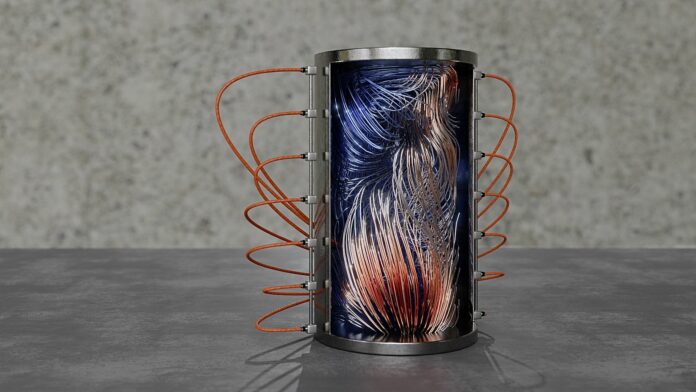Rayleigh-Bénard convection (RBC) is a classical hydrodynamic paradigm used to examine the properties of turbulent flows in a fluid layer defined by a chilled top plate and a heated bottom plate. Despite its simple structure, this idealized configuration offers significant insights into the chaotic, dissipative, and nonlinear dynamics of hydrodynamic systems and mimics numerous flows in nature and industry.
Recent work attempts to investigate the large-scale circulation (LSC) dynamics and manifestation in turbulent liquid metal convection. Using a technique they devised themselves, a team at the Helmholtz-Zentrum Dresden-Rossendorf (HZDR) has now produced a detailed three-dimensional image of a turbulent temperature-driven liquid metal flow for the first time.
A seemingly straightforward experiment that involves filling a container with fluid, heating the base plate, and simultaneously cooling the lid has been used by scientists for many years to explore turbulent fluxes in fluids. A team at the Institute of Fluid Dynamics at HZDR is investigating the nuances of this process.
Team leader Dr. Thomas Wondrak said, “If the temperature difference in the fluid exceeds a certain limit, the heat transport is drastically increased.”
Convective flow effectively transfers heat, which is why this happens. The colder layers at the top sink downward because of their higher density, while the liquid at the bottom expands, becomes lighter, and ascends upward. At first, there is a regular circulation, but the flow gets more turbulent as the temperature disparities widen. It is difficult to visualize this process accurately in three dimensions.
This measurement method, contactless inductive flow tomography (CIFT), was created at HZDR. Using CIFT, researchers can see three-dimensional flows in liquids that carry electricity. This method works on the principle of motion induction, whereby the motion of a liquid in the presence of a static magnetic field produces an electric current.
It is possible to detect the original magnetic field outside the vessel before these eddy currents change it. This makes it possible to use the proper mathematical techniques to infer the flow structure from the distribution of the magnetic field.
The temperature-driven flow in a gallium-indium-tin alloy, which melts at about 10 degrees Celsius, was investigated by Wondrak’s group using CIFT. A 64-centimeter-tall cylinder with roughly 50 liters of liquid metal inside is used in the experiment. It is outfitted with 42 susceptible magnetic field sensors and 68 temperature sensors.
Measuring the fragile flow-induced magnetic fields is the primary problem, in addition to the intricate mathematics required to rebuild the velocity field from the magnetic data. Usually, these fields are between two and five orders of magnitude weaker than the magnetic field being applied.
For instance, the flow-induced magnetic field to be measured is only approximately 0.1 microtesla when the excitation field is 1,000 microtesla. To put this into context, the Earth’s magnetic field, which is also measured and deducted from the measurement values, is about 50 microtesla strong.
Wondrak explained the measurements, “The smallest electromagnetic interference, which occurs when electrical devices are switched on, for example, can interfere with the measurement signal and must be filtered out. To keep the influence of interference to a minimum, we only carry out experiments at night.”
Every measurement conducted at night produces abundant experimental flow data that gives researchers fresh perspectives on the complex and constantly shifting flow structures. Even with today’s high-performance computation, numerical calculations for similar flow conditions would take too long. Therefore, this experimental data is invaluable.
Wondrak and his colleagues can discern spatial features in the intricate velocity fields using contemporary mathematical methods. For example, they discovered that the vessel had recurrent patterns of one or more revolving vortices layered on top of one another. This improves our comprehension of the connection between flow patterns and heat transport while bringing some order to the chaotic chaos.
Furthermore, understanding flow dynamics inside planets and stars is one of the many larger-scale geophysics and astrophysics problems that can benefit from the knowledge gathered from laboratory research. Applying dimensionless parameters that come from similarity theory accomplishes this.
Now that contactless inductive flow tomography has been shown to have potential, researchers are working to develop this measurement technique further. To improve measurement accuracy, they intend to increase the excitation magnetic field and investigate the usage of novel magnetic field sensors. Wondrak’s group is hopeful that these advances will soon result in even more profound understandings of turbulent liquid metal flows.
Journal Reference:
- T. Wondrak, M. Sieger, R. Mitra, F. Schindler, F. Stefani, T. Vogt, S. Eckert, Three-dimensional flow structures in turbulent Rayleigh–Bénard convection at low Prandtl number Pr = 0.03, in Journal of Fluid Mechanics, 2023 DOI: 10.1017/jfm.2023.794
